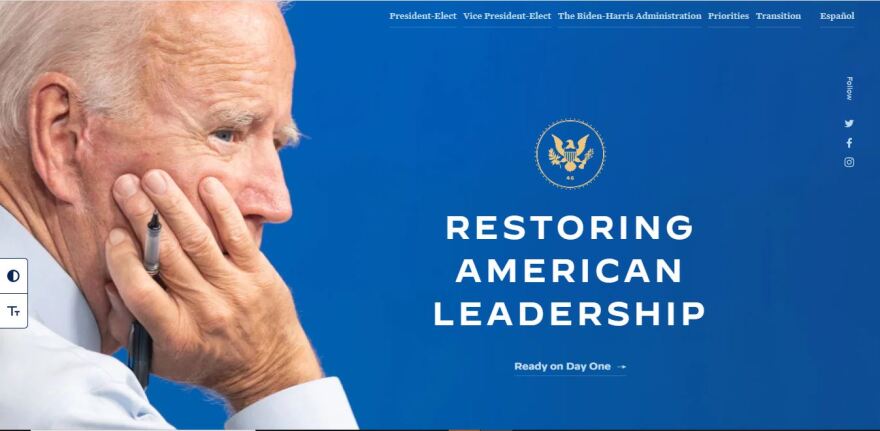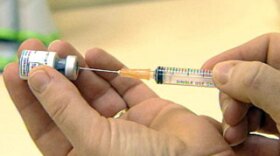While COVID-19 surges across the state, schools are adjusting plans for in-person learning. But the tough calls have been left almost completely to local school districts, as state and federal agencies are offering only minimal guidance.
Back on Oct. 20, students in the Guilford County Schools district were set to return to in-person instruction. It was the culmination of a plan that had been months in the works. Teachers had spaced out desks in classrooms, created reminder plans for students to wear their masks and planned group activities that could be done without sharing supplies.
Then, the day before students were supposed to return, Guilford County Schools Chief of Staff Nora Carr got new data from local health officials.

"It showed us moving as a county from sort of generally being in one category of risk into the highest category of risk for possible transmission in schools," Carr said.
That information led Carr and other school leaders to recommend delaying the reopening.
"And so you’re weighing all these risk factors that kids face about not being in school against the risk factors of community spread and getting COVID-19," Carr said.
During the pandemic, local school boards are consulting directly with county health departments – and state and federal guidance is useful, but more indirect.
On the state level, health officials have weekly conversations with district leaders. And worked with the state Department of Public Instruction to develop guidance on how to reopen schools safely and a decision tree on when to reopen schools via the Strong Schools NC Public Health Toolkit (K-12), which you can read in full here.

The federal Centers for Disease Control and Prevention's guidance uses a color-coded system and weighs prevention measures and positive test rates. Green is good. Red is not. And North Carolina, as a state, is certainly closer to red than green.
Susan Gale Perry, the chief deputy secretary of the state health department, says there's a reason the state has not issued specific cutoffs on when to hold in person classes.
"Even if you look at the C.D.C., a big part of those metrics are around, really, the capacity of the school or the school district to implement those mitigation strategies," Perry said.
She said it's important to remain flexible, especially as circumstances change and new research teaches us more about the virus.
"We feel comfortable saying that all 100 of our counties could make a choice right now to open their schools for in-person instruction at the Plan A which would be allowing all elementary students to come back in person and at Plan B for middle and high school students," Perry said.
Since the buck stops with local school districts, a scattershot approach has emerged across the state. Some districts have sought guidance that goes further than what state and federal health officials have offered.
Charlotte-Mecklenburg Schools' template goes beyond just the green, yellow and red, and gives hard numbers for when schools should be shut down.

Durham and Wake County Schools are participating in the ABC Science Collaborative to inform their decisions. They work with scientists and physicians to advise on reopening plans. And their research is referenced by school board members like Jim Martin, at last week’s Wake School Board meeting.
"Doctor Benjamin shared with us numbers from his studies, and from his studies, we can be confident in the hybrid model,” Martin said while discussing with other members what the best plan for the spring semester and beyond would be.
Debates about numerous reopening plans and ideas have been heated at times. Board members are not only weighing the needs of students, teachers and families with every decision, but also citizens' health across the entire county. And that makes Wake not unlike any other school district in the state.
Even Wake County Schools and Durham Public Schools have come to different conclusions about what the right reopening plan is this semester. Wake brought a number of students back in person, Durham opted to wait until the spring semester.

Strong local control is a long-standing element of the American education system. The federal Department of Education is purposely weak, and state agencies have varying degrees of oversight. In North Carolina, what's good for an urban district like Durham is unlikely to work best for a rural district like Jones County. But the virus is the same in each of those places, and everywhere else. And some local school leaders say that calls for more help from above.
Back in July, in the middle of his reelection campaign, Governor Roy Cooper set the tone for offering broad guidance, but left specific to local authorities.
"Plan B is the baseline for our state. However, as I said earlier, districts can choose Plan C, which requires all remote learning," Cooper said in a news conference announcing reopening plans for schools after he shut them down due to the pandemic in the spring.
As for federal guidance, President Trump has repeatedly blocked his own C.D.C. from giving specifics for school reopening plans, while calling for schools to reopen completely.

But President-elect Joe Biden’s new website says he will provide, “specific, evidence-based guidance,” on when to open or close schools.
"Protecting our students, our educators, our communities, getting our schools opened safely — this is a national emergency," Biden has said.
That national emergency of COVID-19 is ongoing, and predicted to get much, much worse before Inauguration day, even as hundreds of thousands of students in North Carolina return to classrooms.









